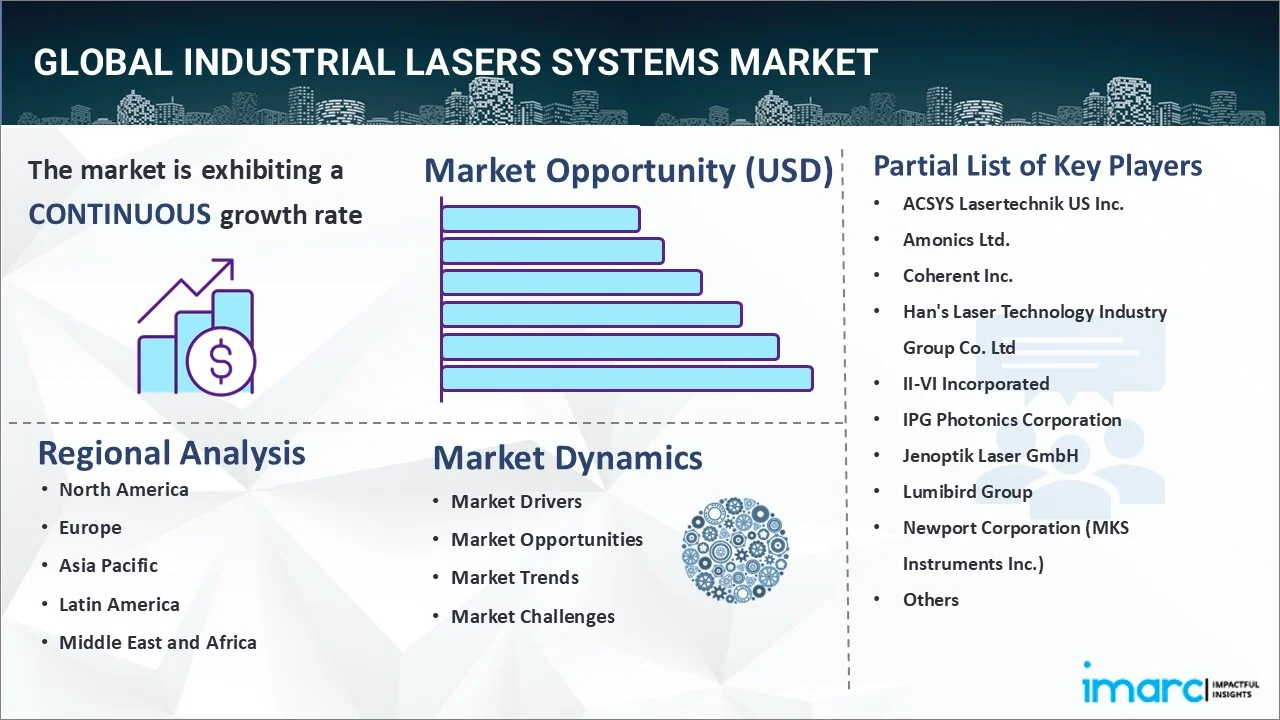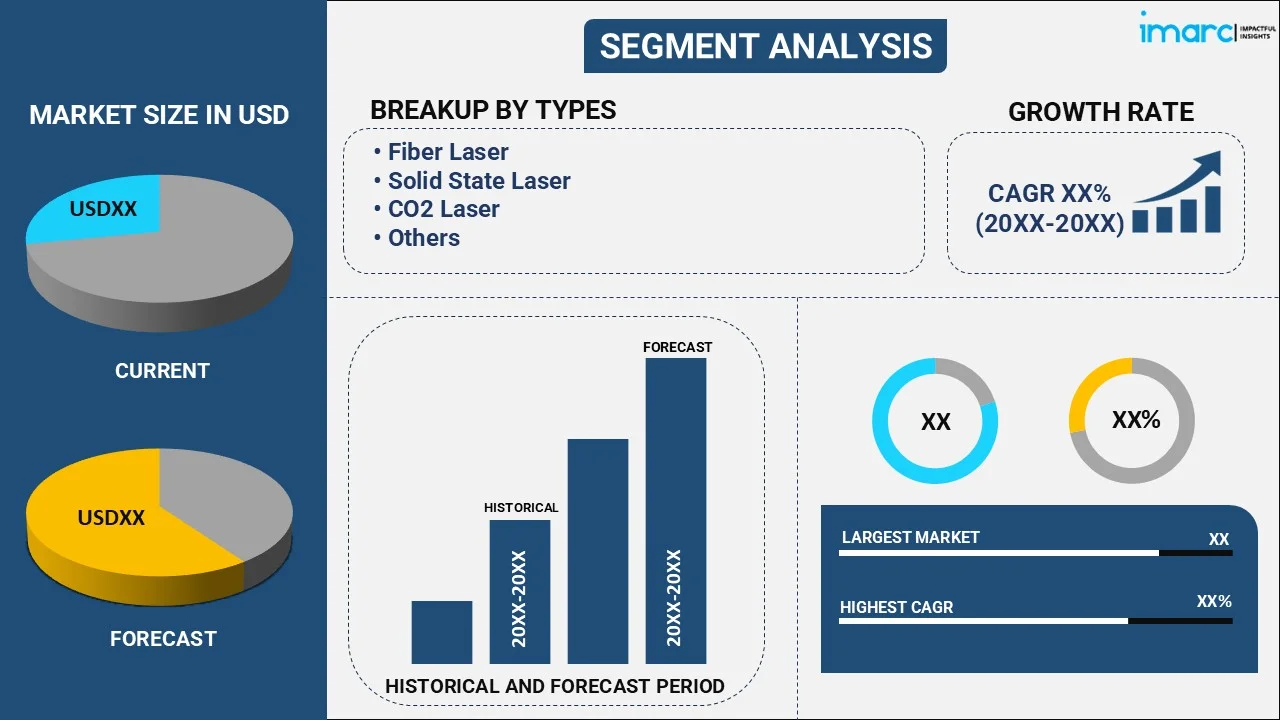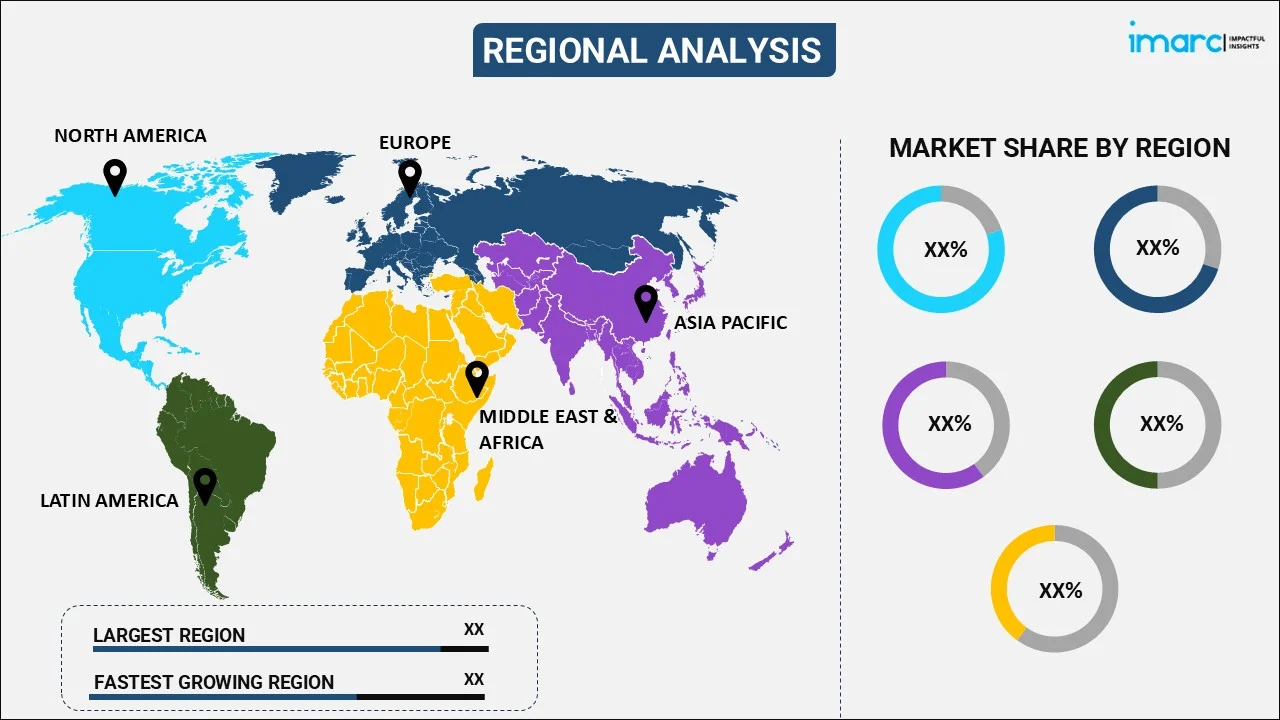
Industrial Lasers Systems Market Repot by Type (Fiber Laser, Solid State Laser, CO2 Laser, and Others), Application (Cutting, Welding, Marking, Drilling, and Others), End Use Industry (Semiconductor and Electronics, Automotive, Aerospace and Defense, Medical, and Others), and Region 2025-2033
Market Overview:
The global industrial lasers systems market size reached USD 22.9 Billion in 2024. Looking forward, IMARC Group expects the market to reach USD 42.8 Billion by 2033, exhibiting a growth rate (CAGR) of 6.82% during 2025-2033. The increasing adoption of lasers for custom markings and engravings, the escalating demand for automation and high-end processing, and various technological advancements in additive manufacturing processes represent some of the key factors driving the market.
|
Report Attribute
|
Key Statistics
|
|---|---|
|
Base Year
|
2024
|
|
Forecast Years
|
2025-2033
|
|
Historical Years
|
2019-2024
|
|
Market Size in 2024
|
USD 22.9 Billion |
|
Market Forecast in 2033
|
USD 42.8 Billion |
| Market Growth Rate 2025-2033 | 6.82% |
Industrial laser systems are highly specialized tools used in various manufacturing and industrial processes that rely on the controlled application of laser light. These systems utilize the unique properties of laser beams, such as high intensity, precision, and focus, to perform a wide range of tasks in industries such as manufacturing, healthcare, aerospace, automotive, electronics offering precise and efficient solutions for cutting, welding, marking, drilling, additive manufacturing, cleaning, and various research and development purposes. These systems play a pivotal role in enhancing the quality, efficiency, and innovation of industrial processes across the globe.

The increasing utilization of lasers for personalized markings and engravings across a spectrum of industries, including automotive, medical, aerospace, defense, and packaging represents a primary driver propelling market expansion. Furthermore, the extensive adoption of fiber lasers for engraving and marking on semiconductors and electronics is exerting substantial impetus on market growth. Fiber lasers, renowned for their output power and optical excellence, present in both continuous and modulated wave modes, are instrumental in imprinting enduring alphanumeric particulars on products. These include brand identities, batch codes, manufacturer insignias, barcodes, logos, and dates. Additionally, the integration of laser systems into additive manufacturing serves as another influential driver. Industrial lasers assume a pivotal role in 3D printing, bolstering efficiency, personalization, while minimizing waste generation and errors in product fabrication.
Industrial Lasers Systems Market Trends/Drivers:
Increasing adoption of lasers for custom markings and engravings
Lasers have found widespread use in various industries, including automotive, medical, aerospace, defense, and packaging, for custom markings and engravings. These applications range from branding and labeling products to enhancing traceability and aesthetic appeal. Moreover, laser markings and engravings are permanent, resistant to wear and tear, and maintain high-quality appearances over time. This durability is especially valuable in sectors where products are subjected to harsh environments or frequent handling. Besides, these systems offer rapid and efficient marking and engraving processes. They can complete tasks quickly, making them ideal for high-throughput manufacturing environments. Moreover, in addition to functional benefits, lasers offer aesthetic advantages. They can create visually appealing and customizable designs, logos, and artwork on products. This customization capability is particularly appealing to industries seeking to differentiate their products and enhance their branding efforts.
Escalating demand for automation and high-end processing
In industries like automotive, aerospace, and electronics manufacturing, precision and consistency are paramount. Industrial laser systems offer a level of precision that is challenging to achieve with manual processes. They can consistently create precise markings, cuts, welds, and engravings, ensuring that each product meets the required quality standards. Besides, industrial laser systems follow programmed instructions with pinpoint accuracy, minimizing defects and variations in the final products. This is crucial for industries where safety, reliability, and product quality are critical. Moreover, automated laser systems can operate at high speeds and work continuously, reducing production time significantly compared to manual methods. This accelerated production is essential for meeting tight deadlines and increasing output.
Various technological advancements
The development of high-power fiber lasers has significantly improved the efficiency and cutting capabilities of industrial laser systems. These lasers provide a more concentrated and intense beam, enabling faster and cleaner cutting, welding, and marking processes. Besides, ultrafast lasers, such as femtosecond and picosecond lasers, offer incredibly short pulse durations. This precision is essential for micro-machining, surface structuring, and delicate material processing, particularly in industries like electronics and medical device manufacturing. Moreover, technological advancements have improved the control of laser beams through advanced optics and beam delivery systems. This allows for precise beam shaping and steering, critical for complex cutting, welding, and drilling tasks.
Industrial Lasers Systems Industry Segmentation:
IMARC Group provides an analysis of the key trends in each segment of the market, along with forecasts at the global, regional and country levels from 2025-2033. Our report has categorized the market based on type, application and end use industry.
Breakup by Type:

- Fiber Laser
- Solid State Laser
- CO2 Laser
- Others
Fiber lasers represent the most used type
The report has provided a detailed breakup and analysis of the market based on the type. This includes fiber laser, solid state laser, CO2 laser, and others. According to the report, fiber lasers represented the largest segment.
Fiber lasers produce high-quality laser beams characterized by excellent focusability and stability. This means they can maintain a consistent beam profile over long distances, ensuring precision in various industrial applications. Moreover, fiber lasers are highly efficient, converting a large percentage of electrical power into laser output. Their efficiency leads to energy savings, making them environmentally friendly and cost-effective for businesses. Besides, these lasers are highly efficient, converting a large percentage of electrical power into laser output. Their efficiency leads to energy savings, making them environmentally friendly and cost-effective for businesses.
Breakup by Application:
- Cutting
- Welding
- Marking
- Drilling
- Others
Cutting holds the largest market share
A detailed breakup and analysis of the market based on the application has also been provided in the report. This includes cutting, welding, marking, drilling, and others. According to the report, cutting represented the largest segment.
Laser cutting systems offer unparalleled precision at a microscopic level. They can cut intricate patterns and shapes with utmost accuracy, making them ideal for industries where precision is critical, such as aerospace and medical device manufacturing. Besides, laser cutting is compatible with a wide variety of materials, including metals (e.g., steel, aluminum, titanium), plastics, wood, ceramics, and composites. This versatility is invaluable as it allows industries to work with diverse materials as per their requirements. Moreover, it can handle intricate and complex designs that may be challenging to achieve with traditional cutting methods. This flexibility is vital for industries where aesthetics and design intricacies matter, such as in jewelry and architectural applications.
Breakup by End Use Industry:
- Semiconductor and Electronics
- Automotive
- Aerospace and Defense
- Medical
- Others
Semiconductor and electronics sector accounts for majority of market share
A detailed breakup and analysis of the market based on the end use industry has also been provided in the report. This includes semiconductor and electronics, automotive, aerospace and defense, medical, and others. According to the report, semiconductor and electronics sector represented the largest segment.
The semiconductor industry relies heavily on precision microfabrication processes to produce ICs. Laser systems are essential for tasks such as wafer dicing, scribing, and drilling tiny holes in silicon wafers, which are the building blocks of electronic devices. Besides, the ongoing trend towards miniaturization in electronics requires increasingly precise and fine-scale manufacturing processes. Laser systems excel in achieving the microscopic accuracy needed for cutting-edge electronic components. Moreover, printed circuit boards (PCBs) are fundamental to electronics manufacturing. Laser systems are used for cutting and drilling PCBs, creating intricate circuit patterns, and marking component placements with precision. This contributes to the quality and reliability of electronic devices.
Breakup by Region:

- North America
- United States
- Canada
- Asia-Pacific
- China
- Japan
- India
- South Korea
- Australia
- Indonesia
- Others
- Europe
- Germany
- France
- United Kingdom
- Italy
- Spain
- Russia
- Others
- Latin America
- Brazil
- Mexico
- Others
- Middle East and Africa
Asia Pacific leads the market, accounting for the largest industrial lasers systems market share
The market research report has also provided a comprehensive analysis of all the major regional markets, which include North America (the United States and Canada); Europe (Germany, France, the United Kingdom, Italy, Spain, Russia, and others); Asia Pacific (China, Japan, India, South Korea, Australia, Indonesia, and others); Latin America (Brazil, Mexico, and others); and the Middle East and Africa. According to the report, Asia Pacific accounted for the largest market share.
Asia Pacific, particularly countries like China, Japan, South Korea, and Taiwan, boasts a robust and diverse manufacturing sector. This region has become a global hub for electronics, automotive, aerospace, and consumer goods manufacturing. The high demand for precision machining and marking in these industries drives the adoption of industrial laser systems. Besides, as industries in the Asia Pacific region increasingly embrace automation and Industry 4.0 technologies, there is a growing need for advanced tools like industrial laser systems. These systems play a pivotal role in automated manufacturing processes, offering precision, speed, and consistency, which are vital for maintaining competitiveness.
Competitive Landscape:
The competitive landscape of the market is characterized by the presence of multiple players that include established brands, emerging startups, and specialty manufacturers. Presently, leading companies are allocating significant resources to research and development to innovate and introduce advanced laser technologies. This includes improving laser efficiency, power, precision, and versatility. They are also expanding their product portfolios by introducing new laser systems with different power levels, wavelengths, and capabilities. This allows them to serve a broader range of industries and applications. Moreover, key companies are collaborating with technology partners, research institutions, and universities for co-developing cutting-edge laser technologies and staying at the forefront of innovation.
The market research report has provided a comprehensive analysis of the competitive landscape. Detailed profiles of all major companies have also been provided. Some of the key players in the market include:
- ACSYS Lasertechnik US Inc.
- Amonics Ltd.
- Coherent Inc.
- Han's Laser Technology Industry Group Co. Ltd
- II-VI Incorporated
- IPG Photonics Corporation
- Jenoptik Laser GmbH
- Lumibird Group
- Newport Corporation (MKS Instruments Inc.)
- NKT Photonics A/S
- Toptica Photonics AG
- TRUMPF
(Please note that this is only a partial list of the key players, and the complete list is provided in the report.)
Recent Developments:
- IPG Photonics Corporation has been focusing on research and development to enhance its product portfolio. The company has introduced the YLR-U series of fiber lasers, which offer high power and efficiency for industrial applications. IPG Photonics has also made advancements in its beam delivery systems, enabling better control and precision in laser processing.
- Coherent Inc. recently announced the launch of several new products. These include the HighLight FL-ARM fiber laser, which offers improved processing capabilities for a wide range of materials. Coherent Inc. has also introduced the ExactWeld 230 P laser welding system, which provides high-quality and precise welding solutions for various applications.
- TRUMPF, a global leader in laser technology, has recently launched the TruMark 6030 marking laser system. It has also expanded its portfolio with the introduction of the TruDisk 1020 disk laser, which offers improved performance and energy efficiency.
Industrial Lasers Systems Market Report Scope:
| Report Features | Details |
|---|---|
| Base Year of the Analysis | 2024 |
| Historical Period | 2019-2024 |
| Forecast Period | 2025-2033 |
| Units | Billion USD |
| Scope of the Report | Exploration of Historical Trends and Market Outlook, Industry Catalysts and Challenges, Segment-Wise Historical and Future Market Assessment:
|
| Types Covered | Fiber Laser, Solid State Laser, CO2 Laser, Others |
| Applications Covered | Cutting, Welding, Marking, Drilling, Others |
| End Use Industries Covered | Semiconductor and Electronics, Automotive, Aerospace and Defense, Medical, Others |
| Regions Covered | Asia Pacific, Europe, North America, Latin America, Middle East and Africa |
| Countries Covered | United States, Canada, Germany, France, United Kingdom, Italy, Spain, Russia, China, Japan, India, South Korea, Australia, Indonesia, Brazil, Mexico |
| Companies Covered | ACSYS Lasertechnik US Inc., Amonics Ltd., Coherent Inc., Han's Laser Technology Industry Group Co. Ltd, II-VI Incorporated, IPG Photonics Corporation, Jenoptik Laser GmbH, Lumibird Group, Newport Corporation (MKS Instruments Inc.), NKT Photonics A/S, Toptica Photonics AG, TRUMPF. etc. |
| Customization Scope | 10% Free Customization |
| Post-Sale Analyst Support | 10-12 Weeks |
| Delivery Format | PDF and Excel through Email (We can also provide the editable version of the report in PPT/Word format on special request) |
Key Benefits for Stakeholders:
- IMARC’s industry report offers a comprehensive quantitative analysis of various market segments, historical and current market trends, market forecasts, and dynamics of the industrial lasers systems market from 2019-2033.
- The research report provides the latest information on the market drivers, challenges, and opportunities in the global industrial lasers systems market.
- The study maps the leading, as well as the fastest-growing, regional markets. It further enables stakeholders to identify the key country-level markets within each region.
- Porter's five forces analysis assist stakeholders in assessing the impact of new entrants, competitive rivalry, supplier power, buyer power, and the threat of substitution. It helps stakeholders to analyze the level of competition within the industrial lasers systems industry and its attractiveness.
- Competitive landscape allows stakeholders to understand their competitive environment and provides an insight into the current positions of key players in the market.
Key Questions Answered in This Report
The global industrial lasers systems market was valued at USD 22.9 Billion in 2024.
We expect the global industrial lasers systems market to exhibit a CAGR of 6.82% during 2025-2033.
The rising utilization of industrial laser systems for 3D printing, custom markings, engravings, and printing permanent alphanumeric details on products, such as brand names, bar codes, logos, etc., is primarily the global industrial lasers systems market.
The sudden outbreak of the COVID-19 pandemic had led to the implementation of stringent lockdown regulations across several nations resulting in temporary closure of numerous end-use industries for industrial laser systems.
Based on the type, the global industrial lasers systems market can be segmented into fiber laser, solid state laser, CO2 laser, and others. Currently, fiber laser holds the majority of the total market share.
Based on the application, the global industrial lasers systems market has been divided into cutting, welding, marking, drilling, and others. Among these, cutting exhibits a clear dominance in the market.
Based on the end use industry, the global industrial lasers systems market can be categorized into semiconductor and electronics, automotive, aerospace and defense, medical, and others. Currently, the semiconductor and electronics industry accounts for the largest market share.
On a regional level, the market has been classified into North America, Asia-Pacific, Europe, Latin America, and Middle East and Africa, where Asia-Pacific currently dominates the global market.
Some of the major players in the global industrial lasers systems market include ACSYS Lasertechnik US Inc., Amonics Ltd., Coherent Inc., Han's Laser Technology Industry Group Co. Ltd, II-VI Incorporated, IPG Photonics Corporation, Jenoptik Laser GmbH, Lumibird Group, Newport Corporation (MKS Instruments Inc.), NKT Photonics A/S, Toptica Photonics AG, and TRUMPF.
Need more help?
- Speak to our experienced analysts for insights on the current market scenarios.
- Include additional segments and countries to customize the report as per your requirement.
- Gain an unparalleled competitive advantage in your domain by understanding how to utilize the report and positively impacting your operations and revenue.
- For further assistance, please connect with our analysts.
 Inquire Before Buying
Inquire Before Buying
 Speak to an Analyst
Speak to an Analyst
 Request Brochure
Request Brochure
 Request Customization
Request Customization




.webp)




.webp)












